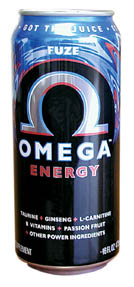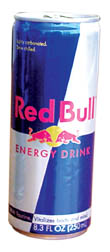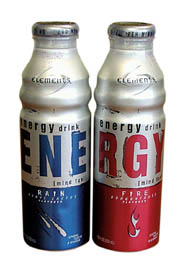
Since its inception in 1997, the energy drinks category has enjoyed tremendous growth, with sales jumping 465% between 1998 and 2003, a 401% increase at constant prices, according to Mintel International Group (Chicago). Total sales of the category stand at nearly $1 billion, but in the recent report on the U.S. energy drinks market, Mintel regards energy drinks as a niche market, a status unlikely to change.
Energy drinks account for only 2% of the larger $60 billion carbonated soft drink market, yet this niche does have potential. Only 11% of the adult population consumes energy drinks, but perhaps the most telling statistic is the number of teens with a taste for the beverages. According to the Fall 2002 Simmons (New York) Teens survey, 18% of teenagers consume energy drinks.
Mintel defines energy drinks as beverages bearing a specific claim to boost energy or stimulation. Marketing efforts emphasize the drinks' energizing benefits; among their active ingredients are glucose, caffeine and taurine, though other health-oriented ingredients, vitamins and minerals also may be included. For the most part, grassroots marketing is the preferred method of promotion, including sampling and event sponsorship, but the maturing category is expected to turn to traditional forms of advertising (i.e., print and other media) as larger manufacturers entering the market bring their expertise—and advertising budgets. For that matter, television ads have begun appearing for Red Bull (Pacific Palisades, Calif.), one of the category's old-timers, in the U.S. market since the late 1990s.

The Bull by the Horns
Red Bull long has been the category leader, no small feat to be sure, but that also has made it a target of companies large and small. The entry of such major beverage players as Coca-Cola (Atlanta) and PepsiCo (Purchase, N.Y.) has taken a quick and dramatic toll on Red Bull, diminishing its market share from 80.8% in 2000 to 51.4% just two years later. Nevertheless, Red Bull remains a commanding presence in the market, accounting for $54.3 million in 2002 sales, barely less than the $54.7 million in combined sales of Coca-Cola's KMX and PepsiCo's big three energy drinks (Total, SoBe Adrenaline Rush and AMP). Red Bull may hold an even greater overall share of market, considering the brand's strength in convenience stores and on-premises channels.Energy drinks first found favor in convenience stores, and these outlets still account for the majority of sales, as much as 60% of 2003 sales by some estimates. As the market changes, however, so does its distribution, and the entry of major players has resulted in stronger sales at food stores, drug stores and mass merchandisers (FDM).
Thanks to their marketing and distribution power into such FDM areas, Coca-Cola and PepsiCo have managed to expand the market to unprecedented levels and, when combined with Red Bull, account for nearly 90% of the category's sales at the FDM level. Mintel notes “countless” entries from smaller companies and start-ups all looking for a point of differentiation. Ultimately, Red Bull's primary competition will be from Coca-Cola, PepsiCo, Cadbury-Schweppes (Stamford, Conn.) and Anheuser-Busch (St. Louis). Mintel also notes the category will support a limited number of participants, probably no more than 10. Private label energy drinks have yet to appear, but these are possible in the future, depending on how mainstream the category becomes.
Mintel's exclusive consumer research finds 11% of respondents consuming energy drinks, and a closer look at the data reveals what could be a prime market for manufacturers. The highest incidence is among males, those aged 18-24 and Hispanics. The 18-24 year-old demographic is no surprise, as this always has been heralded as the segment's core consumer. However, Hispanics are a new and significant factor, considering the large and growing Hispanic population in the U.S.
The category, therefore, would be well-served to broaden its appeal, and Mintel suggests widening the demographic focus to target such groups as Hispanics, African-Americans and women. Already, one smaller manufacturer is differentiating itself by marketing a product geared to women. In the process, TwinLabs' (Hauppauge, N.Y.) Energy Drink for Women also attempts to attract a wider age group, as it is focused on women of all ages, and not just older teens and those in their 20s. The older consumer may hold unheralded promise for energy drinks, as this audience increasingly seeks an anti-aging antidote and natural energy sources. When focusing on this group, however, marketers must be aware of seniors' concerns about the active ingredients in the products they consume.
One such move to attract a wider audience has been through the addition of more diet-conscious products. Red Bull, Hansen's Natural (Corona, Calif.) and Rockstar (Las Vegas) have introduced sugar-free energy drinks.
Why Not?
Survey respondents who do not consume energy drinks listed health concerns and levels of caffeine and other stimulants as the top reason for shunning the beverages. Those aged 45-64 were the most likely to express health concerns, but taste and price were deterrents for other groups, particularly young people and those with lower household incomes. These two groups were more likely to dislike the taste of energy drinks. However, no single reason stood out from the pack, leading Mintel to speculate that the public (consumers and non-consumers alike) “are not overwhelmingly concerned about the health implications of drinking energy drinks,” but this could change.Such a change may arrive in the form of regulatory control of energy drinks. Currently, the beverages are unregulated in the U.S., but guidelines specifying the amount of active ingredients that can be used safely in a product could negatively affect sales of the market. Indeed, regulators in Europe are questioning Red Bull, and even this international attention could have negative implications in the U.S. market. In Norway, Red Bull is classified as a medicine and has had its sale banned in retail outlets, due to an excessive caffeine amount (greater than the country's 150mg limit).
The product also has had negative publicity elsewhere. Sweden's health agency issued a warning against Red Bull in 2001 after the product was associated with the deaths of three young people. Switzerland and Hong Kong have seen similar Red Bull-related deaths although, in both of these countries, the product had been consumed with high amounts of alcohol.
Caffeine has been generally regarded as safe (GRAS) since 1958, but debate persists regarding the acceptable level of caffeine in energy drinks. The 1994 Dietary Supplement Health and Education Act (DSHEA) determined that dietary supplements, such as those found in energy drinks, cannot be regarded as drugs or measured against drug standards. The Food and Drug Administration (FDA) has no regulation in place pertaining to the use of many of the ingredients regularly found in energy drinks, including the specific approved list, levels of legal use, and what mixtures are safe. “The result,” Mintel finds, “is that the average consumer does not know whether 200mg or 80mg of caffeine is safe, and many are unaware of the effects of 100mg, 10,000mg or even 1mg of taurine.” Regulations require listing caffeine among the ingredients but do not demand detailing the actual amount.
Such regulatory involvement could have positive consequences for the energy drinks market in the U.S., as some of those non-consumers who cite health concerns as their primary reason may take comfort in the FDA's involvement. The answer could be as simple as listing specific ingredient levels.
Ingredients may play an even greater role as the market matures and segments for, in the future, energy drinks likely will be marketed to offer stimulation plus calcium, stimulation plus hydration, or stimulation plus B vitamins. In the process, the distinction between energy drinks, energy supplements and functional beverages would continue to blur.

In the Can
As the market evolves, packaging and package size are expected to grow beyond the standard 8.4oz. aluminum can so prevalent now. As new manufacturers seek to differentiate themselves, energy drinks can be found in resealable glass and aluminum bottles, 16oz. cans and 20oz. plastic bottles. Mintel's research finds little brand loyalty among consumers of energy drinks, and a willingness to try a new product if the brand of choice is not available. This suggests the possibility that consumers could be swayed by the appeal of an intriguing package.
Mintel expects the energy drinks market to see an increase in low-calorie versions and in sizes larger than the typical 250ml can, as well as more products offering stimulation and refreshment. Consumers will continue to focus on the functionality of ingredients such as taurine and caffeine, while manufacturers may emphasize packaging (such as aluminum bottle cans) rather than flavors. However, the most interesting developments could be a blurring between supplement beverages and sports and energy drinks. Mintel believes this could involve the usage of antioxidants and skincare ingredients.
Good Sports
Though not enjoying the dramatic growth of its stimulating sibling, sports drinks managed to outperform most other beverages between 1998 and 2003. Sales of sports drinks have grown 14% or more in each of those years, with the largest growth (28%) occurring in 2003. Much of that growth has resulted from rising sales of sports drink leaders Gatorade (now owned by PepsiCo) and POWERade. Line extensions by each have resulted in a wider range of flavors and helped to expand the demographic range, particularly helping to reach pre-teens.The power of the Gatorade brand is undeniable, as evidenced by its market share and ability to innovate and connect with consumers. Despite being one of the first sports drinks, Gatorade managed to augment its already-sizable market share in 2002, increasing it from 82.8% in 2001 to 84%. In its first repackaging since 1999, Gatorade revamped all six of its lines in 2003, to achieve consistency among its products. Each line's packaging (except All-Stars) now includes “Rehydrate. Replenish. Refuel.”--terms featured prominently in advertising. The addition of five new flavors in 2003--Berry Citrus, Ice Watermelon, Fierce Strawberry, Propel Peach, and Propel Kiwi-Strawberry--left Gatorade with a total of 26 SKUs.
POWERade, Coca-Coa's take on the sports drink, enjoyed a growth in market share, albeit a nominal 0.1% between 2001 and 2002, but the company may have begun a new segment. The “hybrid drink” has all of the hydration benefits of sports drinks plus the stimulating boost of an energy drink. Psych and Raize are POWERade extensions, launched in 2003.
All Sport--the sports drink formerly under the PepsiCo banner but acquired by Monarch in the wake of PepsiCo's Gatorade purchase--lost 1% of market share in the time under review. However, Monarch is hopeful its added-value packaging, “Chill-In” bottles, will encourage consumer loyalty.
Similar to energy drinks, Mintel believes sports drinks manufacturers would be well served to emphasize packaging efforts over flavors, again noting the emergence of the aluminum bottle can and its potential for differentiation.
For more information on the reports mentioned in this article, “The U.S. Energy Drinks Market” and “The RTD Non-Carbonated Beverages Market” (the source for the sports drink information), contact Mintel International Group Ltd.; 213 W. Institute Place, Suite 208; Chicago, IL 60610; phone: 312-932-0400.
